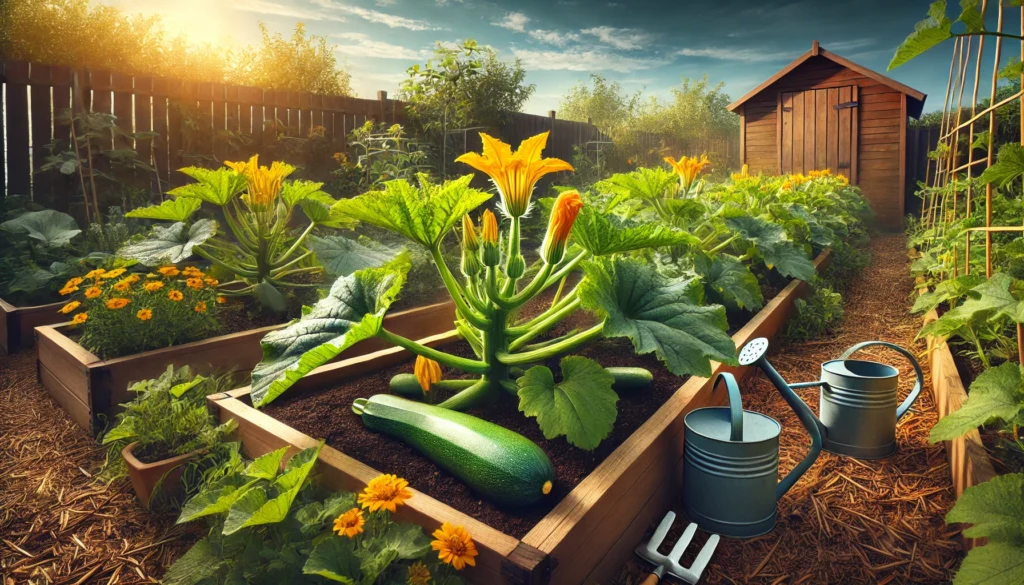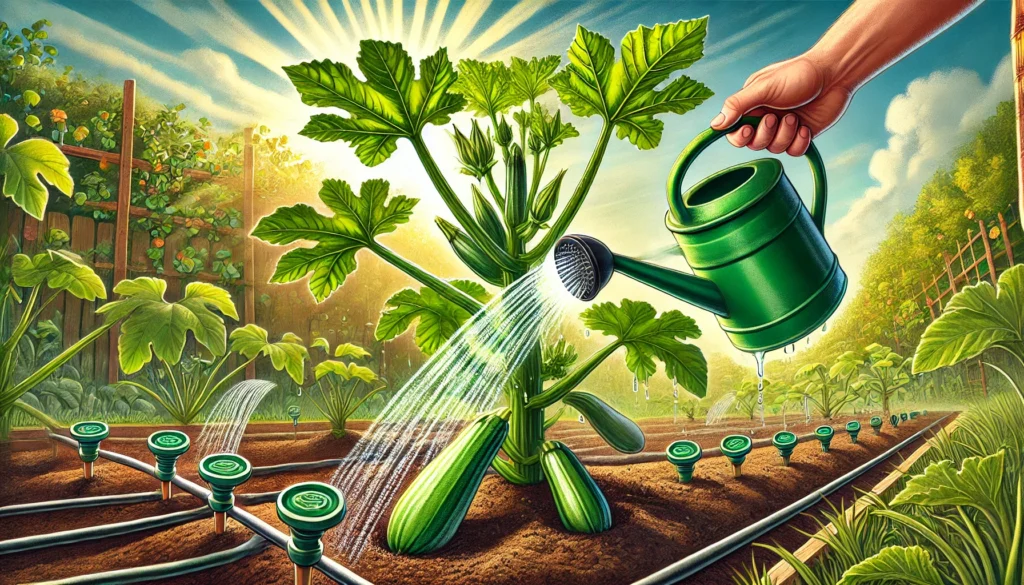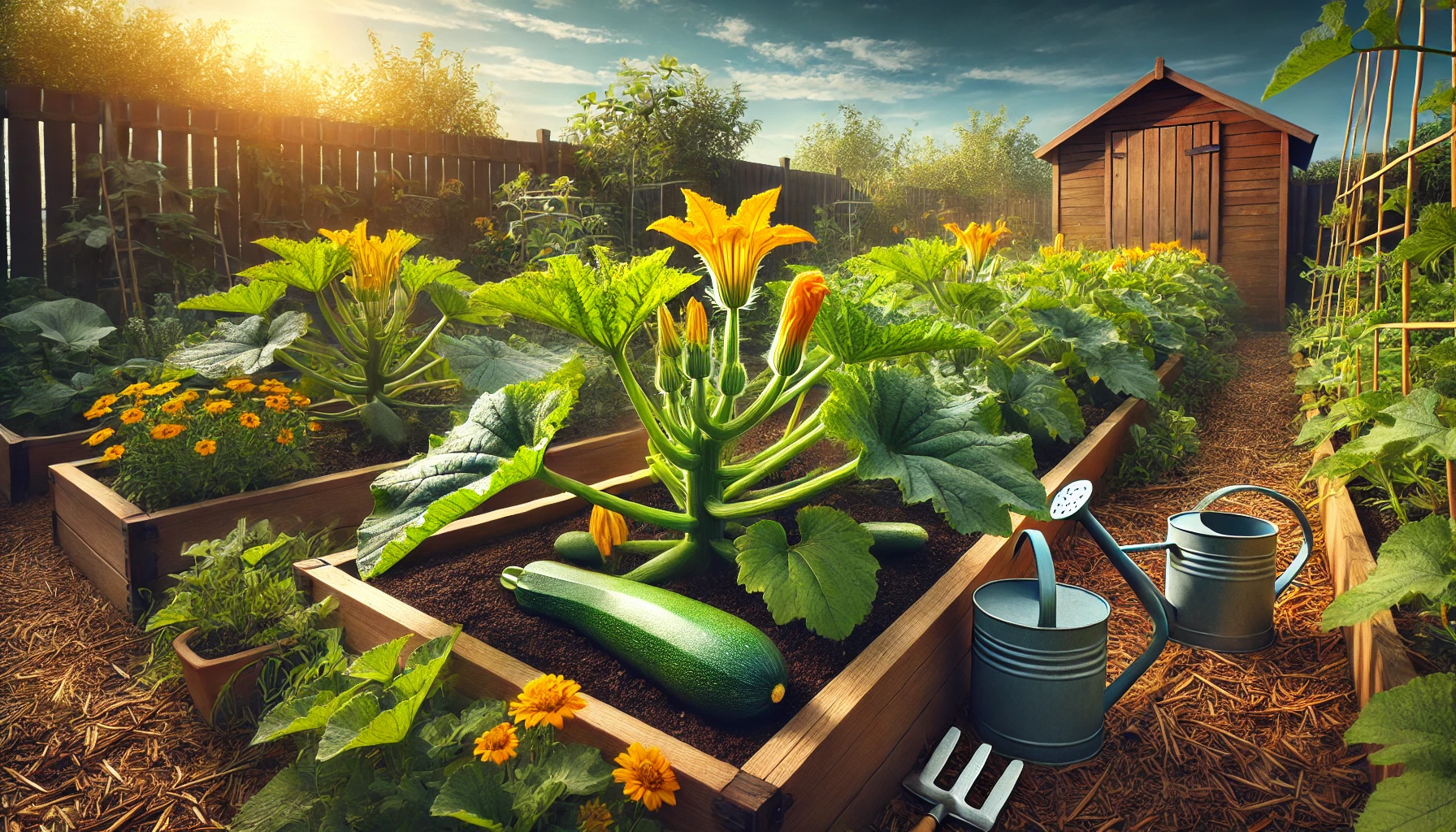Zucchini is one of the most rewarding vegetables to grow in a home garden, known for its versatility in the kitchen and its ability to produce abundant harvests with relatively little effort. Whether you’re a seasoned gardener or a beginner, understanding the nuances of growing zucchini can significantly boost your success. With the right care and strategies, zucchini can thrive in a variety of climates, making it an excellent choice for summer gardens. This guide provides 7 expert tips to help you grow zucchini like a pro, ensuring a bountiful and healthy harvest.

Table of Contents
Introduction to Growing Zucchini
Zucchini, a type of summer squash, has become a staple in home gardens due to its high productivity, ease of growth, and culinary versatility. This fast-growing vegetable can be steamed, grilled, baked, or even spiralized into healthy noodles, making it a popular choice for gardeners and cooks alike. Beyond its versatility, zucchini is a prolific producer, capable of yielding multiple fruits per plant over the growing season. Its adaptability to different growing conditions further cements its reputation as an ideal crop for gardeners at all skill levels.
To ensure success when growing zucchini, it’s crucial to follow proven strategies. This guide focuses on 7 expert tips that address every stage of zucchini cultivation, from choosing the right variety to harvesting effectively. By implementing these tips, you can maximize your zucchini yield and enjoy a thriving, disease-free garden. Whether you’re working with a spacious backyard or a compact container garden, zucchini is a plant that delivers impressive results with the right care.
Choosing the Right Zucchini Varieties
Selecting the right zucchini variety is the first step to a successful harvest. Zucchini comes in two primary types: vining and bush varieties. Vining varieties, such as ‘Costata Romanesco’ and ‘Tromboncino,’ grow long, trailing stems and are best suited for gardens with ample space or vertical trellises. Bush varieties, like ‘Black Beauty’ and ‘Patio Star,’ are compact and perfect for small gardens or container planting. Each variety has its own benefits, from unique flavors to disease resistance, making it important to choose a type that aligns with your space and climate.
Tip 1: Choose the Right Zucchini Variety
When selecting a variety, consider factors such as garden size, local climate, and your culinary preferences. Bush varieties are ideal for urban gardeners or those with limited space, while vining types can take advantage of vertical gardening techniques. Additionally, look for varieties known for their disease resistance, such as ‘Raven’ or ‘Gold Rush,’ which can save time and effort in pest and disease management.
Ideal Growing Conditions for Zucchini
Zucchini thrives in warm, sunny conditions and requires specific environmental factors to reach its full potential. The ideal temperature range for growing zucchini is 70°F to 85°F (21°C to 29°C), and the plants need at least 6 to 8 hours of direct sunlight each day. Without sufficient sunlight, zucchini plants may grow spindly and produce fewer fruits.
In terms of soil, zucchini prefers well-draining, nutrient-rich soil with a pH level between 6.0 and 7.5. Adding organic matter like compost or well-rotted manure can improve soil structure and fertility. Mulching around the plants can help retain moisture, regulate soil temperature, and suppress weeds, creating a favorable environment for zucchini growth.
Tip 2: Plant in Full Sun
Ensure your zucchini plants receive full sun to promote vigorous growth and abundant flowering. A sunny location will not only support photosynthesis but also help prevent fungal diseases, as sunlight dries excess moisture on leaves.
Planting Zucchini: Step-by-Step Guide
Planting zucchini correctly sets the stage for a healthy and productive crop. Start by planting seeds directly into the ground after the danger of frost has passed, or transplant seedlings that are 3-4 weeks old. Prepare the soil by loosening it to a depth of 12 inches and incorporating compost or organic fertilizer. For in-ground planting, space seeds or seedlings 24-36 inches apart for bush varieties and 36-48 inches apart for vining types.
Container planting is also an excellent option for zucchini. Use a container at least 12 inches deep with drainage holes, and fill it with high-quality potting soil enriched with compost. Water the soil thoroughly after planting and monitor moisture levels consistently.
Tip 3: Maintain Consistent Moisture
Zucchini plants require steady moisture to grow properly. Water deeply once or twice a week, ensuring the soil remains evenly moist but not soggy. Inconsistent watering can lead to issues such as blossom end rot or stunted growth.
Watering and Fertilization for Zucchini

Zucchini has high water and nutrient demands due to its rapid growth and prolific fruiting. Watering deeply and consistently is key to keeping zucchini healthy. During dry periods, provide 1-2 inches of water per week and consider using drip irrigation to deliver water directly to the roots. Overhead watering should be avoided as it increases the risk of fungal diseases.
Fertilizing zucchini regularly ensures robust growth and high yields. Begin with a balanced fertilizer at planting time, and switch to a phosphorus-rich fertilizer once the plants start flowering. Organic options like compost tea or fish emulsion work well to promote healthy fruit development.
Tip 4: Fertilize Regularly
Feed your zucchini plants every 4-6 weeks with organic or slow-release fertilizers. This will replenish nutrients in the soil, ensuring that your plants have the energy to produce an abundant harvest.
Pest and Disease Management
Zucchini plants are prone to several pests and diseases, but preventive measures can keep problems under control. Common pests include squash bugs, cucumber beetles, and vine borers, which can cause significant damage if left unchecked. Hand-pick pests when spotted, and use row covers to protect young plants. Natural pest control methods, such as introducing beneficial insects like ladybugs, can also be effective.
Diseases such as powdery mildew and blossom end rot can affect zucchini plants, especially in humid conditions. Proper spacing, pruning for airflow, and avoiding wet leaves can reduce disease risks. Fungicides like neem oil can be applied preventively during damp weather.
Tip 5: Protect Against Pests
Be proactive in pest management by checking plants regularly and using organic solutions. Early detection and intervention are essential to prevent infestations from escalating.
Harvesting Zucchini and Maximizing Yield
Harvest zucchini when fruits are 6-8 inches long for the best flavor and texture. Larger zucchinis can become tough and seedy, so regular harvesting is crucial. Use a sharp knife or garden shears to cut fruits cleanly from the stem, leaving the plant intact to continue producing.
Frequent harvesting encourages the plant to focus its energy on producing new fruits. In addition to harvesting regularly, prune excess foliage to improve airflow and sunlight penetration, which supports overall plant health and productivity.
Tip 6: Prune for Better Airflow
Remove lower leaves and any crowded stems to reduce humidity around the plant, minimizing the risk of disease and promoting better fruit development.
Tip 7: Harvest Frequently
Pick zucchinis every few days to keep plants productive. Allowing fruits to overgrow can slow down production and affect the plant’s overall health.
20 FAQs About Growing Zucchini
1. When is the best time to plant zucchini?
Zucchini thrives in warm temperatures and should be planted after the danger of frost has passed. In most regions, this means late spring to early summer. If starting indoors, sow seeds 3-4 weeks before the last frost date. Outdoor planting should only occur when the soil temperature is consistently above 60°F (15°C). Use row covers for additional warmth if planting early. Ensure the area receives full sunlight for at least 6 hours daily. Plant seeds or seedlings directly into prepared soil with adequate spacing. Zucchini planted too early in cold soil will struggle to germinate or grow.
2. How much sunlight do zucchini plants nee
Zucchini requires full sun, which means at least 6-8 hours of direct sunlight daily. Insufficient light results in leggy plants and reduced flowering. Choose a sunny spot in your garden with minimal shade from trees or buildings. If growing in containers, position them on a south-facing patio or balcony. Sunlight boosts photosynthesis, helping plants grow stronger and produce more fruits. For regions with intense summer heat, some afternoon shade can prevent plant stress. Rotate planting spots each year to avoid soil exhaustion. Monitor leaves for signs of insufficient sunlight, like yellowing or slow growth.
3. What type of soil is best for growing zucchini?
Zucchini grows best in well-draining, fertile soil rich in organic matter. The soil pH should range between 6.0 and 7.5 for optimal nutrient uptake. Before planting, amend the soil with compost or aged manure to improve its texture and fertility. Loamy soil with good aeration supports healthy root development. Avoid clay-heavy soil, which retains too much water and risks root rot. Raised beds or mounds can improve drainage in waterlogged areas. Regular soil testing ensures proper nutrient balance. Mulch around plants to retain moisture and reduce weed competition.
4. How often should I water zucchini plants?
Zucchini needs consistent moisture, especially during flowering and fruiting stages. Water deeply 1-2 times a week, providing 1-2 inches of water each time. During hot, dry weather, increase watering frequency to prevent wilting. Use drip irrigation or water at the base of the plant to avoid wetting the leaves, which can lead to diseases like powdery mildew. Mulching helps retain soil moisture and reduces evaporation. Check soil moisture regularly; the top 2 inches should remain damp but not soggy. Overwatering can cause root rot, so ensure proper drainage.
5. How can I prevent pests from damaging my zucchini plants?
Common zucchini pests include squash bugs, vine borers, and aphids. Use row covers early in the season to protect young plants. Inspect plants regularly for eggs or signs of damage and remove pests by hand. Introduce beneficial insects like ladybugs or lacewings to control aphid populations. Apply organic sprays like neem oil to deter pests without harming pollinators. Keep the garden clean by removing plant debris where pests may hide. Companion planting with marigolds or nasturtiums can repel harmful insects. Rotate crops yearly to avoid pest buildup in the soil.
6. How do I know when to harvest zucchini?
Harvest zucchini when they’re 6-8 inches long for the best flavor and texture. Larger zucchinis may become tough, seedy, and less desirable for eating. Use a sharp knife or garden shears to cut the fruit cleanly from the stem. Check plants every few days, as zucchinis grow rapidly. Regular harvesting encourages the plant to produce more fruit. For baby zucchinis, pick them at around 4 inches. Avoid letting fruits overgrow, as this can reduce overall yield. Handle fruits gently to avoid bruising or damaging the plant.
7. Can zucchini grow in containers?
Yes, zucchini grows well in containers if the pot is large enough. Use a container at least 12 inches deep with good drainage holes. Fill it with high-quality potting soil mixed with compost for added nutrients. Bush varieties like ‘Patio Star’ are ideal for containers due to their compact growth. Place the container in full sun and water frequently, as soil in pots dries out faster. Support plants with a stake or small trellis to keep them upright. Fertilize every 4-6 weeks with organic fertilizer. Monitor for pests and adjust watering to prevent over-drying.
8. What causes yellowing leaves on zucchini plants?
Yellowing leaves, or chlorosis, can result from nutrient deficiencies, overwatering, or pests. Lack of nitrogen is a common cause; amend soil with compost or apply a balanced fertilizer. Overwatering can suffocate roots, causing leaves to turn yellow and wilt. Ensure proper drainage to avoid waterlogged soil. Pests like aphids or whiteflies may suck sap from leaves, leading to discoloration. Check the undersides of leaves for pests and treat with neem oil or insecticidal soap. Fungal diseases like powdery mildew can also cause yellowing; ensure proper spacing for airflow.
9. Why are my zucchini flowers falling off?
Male flowers naturally fall off after releasing pollen, which is normal. Female flowers may fall off if they aren’t pollinated. Poor pollination occurs due to a lack of pollinators or excessive heat. Attract bees by planting pollinator-friendly flowers near your zucchini. Hand-pollinate flowers using a small brush or by gently transferring pollen from male to female flowers. Ensure plants are well-watered, as drought stress can cause flower drop. Overfertilization with nitrogen-rich fertilizers may lead to excessive foliage and fewer flowers. Monitor weather conditions, as extreme heat can affect flower viability.
10. Can zucchini cross-pollinate with other squash?
Yes, zucchini can cross-pollinate with other members of the same species, Cucurbita pepo. This includes pumpkins, certain squashes, and gourds. However, the resulting hybrid seeds only affect the next generation and not the current season’s fruit. If you’re saving seeds, avoid planting different C. pepo varieties close together. Hand-pollination can ensure pure seeds for specific varieties. Cross-pollination doesn’t impact fruit flavor or quality during the growing season. If cross-pollination isn’t a concern, enjoy growing multiple varieties for a diverse harvest.
11. How can I improve pollination for my zucchini plants?
Zucchini relies on pollinators like bees to transfer pollen from male to female flowers. To attract pollinators, plant flowers like marigolds, sunflowers, or lavender nearby. Avoid using pesticides that may harm beneficial insects. If pollination is insufficient, hand-pollinate using a small paintbrush or cotton swab to transfer pollen from male to female flowers. Perform hand-pollination early in the morning when flowers are fully open. Ensuring proper plant spacing allows pollinators easier access to flowers. Keep the garden free of weeds that may compete for pollinator attention. Regular watering and nutrient-rich soil support healthy flower production.
12. What are the differences between male and female zucchini flowers?
Male zucchini flowers grow on long, thin stems and appear earlier in the growing season. They produce pollen needed for fertilization but do not develop into fruit. Female flowers grow closer to the plant’s base and have a swollen ovary beneath the bloom, which becomes the zucchini. Identifying these differences helps with hand-pollination if needed. Male flowers are often removed for culinary use, leaving females to produce fruit. Both flower types are important for a successful harvest, so avoid removing too many male flowers early on.
13. Why is my zucchini fruit rotting before it matures?
Premature fruit rot is often caused by poor pollination or blossom end rot. Inadequate pollination results in fruits that start growing but fail to develop fully. Blossom end rot occurs due to calcium deficiency, often linked to inconsistent watering. Maintain steady soil moisture to improve calcium uptake. Add calcium-rich amendments like crushed eggshells or gypsum if needed. Avoid over-fertilizing with nitrogen, as it may reduce fruit quality. Inspect plants for pests like squash bugs that damage fruits. Removing rotting fruits promptly prevents disease spread and encourages healthy growth.
14. How do I prevent powdery mildew on zucchini plants?
Powdery mildew is a fungal disease that thrives in humid, poorly ventilated conditions. To prevent it, plant zucchini in areas with good air circulation and ample sunlight. Avoid overhead watering, which increases humidity around leaves; instead, water at the base of plants. Apply fungicidal sprays like neem oil or potassium bicarbonate at the first sign of infection. Mulching reduces soil splash that may spread spores. Prune lower leaves to improve airflow and reduce humidity around the plant. Rotating crops yearly prevents fungal buildup in the soil.
15. How long does it take zucchini to grow and mature?
Zucchini typically takes 45-60 days from planting to harvest, depending on the variety. Seedlings sprout within 5-7 days under ideal conditions. Fruits develop rapidly after flowers are pollinated, often growing to harvestable size within 4-7 days. Check plants daily during peak production to harvest zucchinis at the right stage. Factors like temperature, sunlight, and soil fertility influence growth speed. Bush varieties often mature faster than vining types. Maintaining consistent care ensures a steady supply of zucchini throughout the growing season.
Conclusion
Growing zucchini can be a rewarding experience for gardeners of all skill levels, providing an abundance of fresh, versatile produce throughout the summer. By following the 7 expert tips outlined above—choosing the right variety, planting in full sun, maintaining consistent moisture, fertilizing regularly, protecting against pests, pruning for better airflow, and harvesting frequently—you’ll ensure a thriving and productive zucchini crop. Remember that with proper care and attention, zucchini plants can be among the most reliable and generous contributors to your home garden.
For more insights on growing zucchini, check out this comprehensive guide. If you’re interested in expanding your gardening knowledge, explore related topics like winter gardening tips to heal holiday grief and how to grow coffee in a tropical garden. These resources offer valuable advice to help you make the most of your gardening journey, whether you’re growing zucchini or diversifying into other crops.


2 thoughts on “Growing Zucchini: 7 Expert Tips for Success – Ultimate Guide”